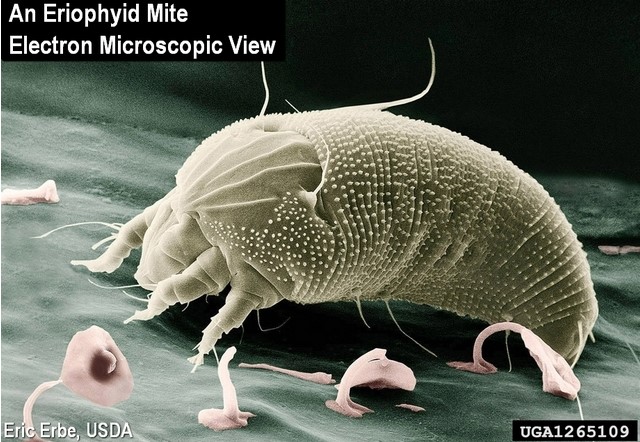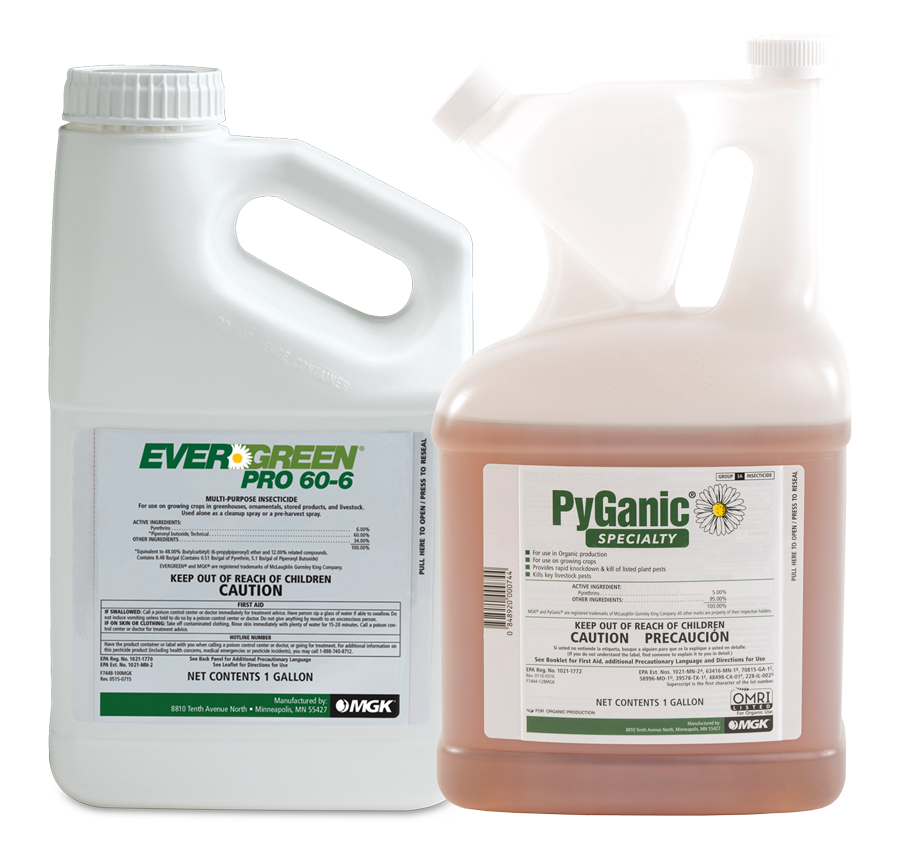We’ve all been there… You are growing your plants in your greenhouse and everything is going great, until it isn’t. The leaves are yellowing or browning, the new growth looks stunted or cupped, and old leaves are even falling off, or perhaps you see strange growths or galls on the plants, but you don’t see any obvious pests. It is possible it is a disease, but first let’s pull out the microscope and take a closer look. You might just have mites. Broad mites, spider mites, and eriophyid mites are all common mite pests that can cause these mysterious symptoms.
How do you know for sure if you have one of these types of mites?
Pull off a few leaves, both old leaves and newer leaves that look damaged or infested, and examine them under a microscope at 10x, 40x or more, depending on how good your eyesight is. Focus on the undersides of leaves when looking for mites and their eggs.
For broad mites specifically, you need to find some eggs, which are about 0.08 mm long and covered in tiny polka dots. The closer you can zoom in, the easier they are to identify. Adult broad mites are a translucent light-green to yellowish color, and the females have a white stripe down their backs. However, the eggs are really the most obvious identifier, with that tell-tale polka dot pattern.

(Picture from Texas Plant Disease and Diagnostics Lab website.)
Spider mites are most easily identifiable by noticing the webbing along with the mites. Adult spider mites have two red eye spots near the head and females two dark splotches, one on each side of the body, and bristly bodies and legs. The eggs are small, clear and spherical.

(Picture from UC Statewide IPM Project, Copyright 2001 Regents, University of California)
Eriophyid mites are elongate and have two pairs of front legs that drag the rest of the body behind it. They can be extremely small with the smallest being around 1/100th of an inch long so that field identification is virtually impossible. They often form galls on the plants and evidence of infestation is often determined by identifying the plant damage rather than trying to see the mite itself. Also note, if these mites are currently inside a gall then pyrethrins and pyrethroids won’t affect them. They are protected inside the gall and only susceptible to non-systemic insecticides like pyrethrins when they are out and about.

(Picture from The Ohio State University website. http://bygl.osu.edu/node/751)
If you determine that you do have mite pests, then what?
Well, there are several options. If you are able to dispose of the infested plants, that can help cut down the overall population quickly, but you still need to manage the mites that are left, and luckily there are several good options. You can use horticultural soaps or oils, or other pesticide options labelled for mites. If you choose to use pesticides, PyGanic Specialty organically derived pyrethrins or EverGreen Pro 60-6 from MGK are good options to crush the mite population initially. These botanically-derived insecticides have a very short residual persistence, so just a few days after application, you can then introduce beneficial predatory mites into your greenhouse to keep the destructive mites from returning in force.
PyGanic Specialty is OMRI listed, it contains pyrethrins, and can be used in certified organic facilities. EverGreen Pro 60-6 is not OMRI listed. It contains PBO in addition to pyrethrins which is a synthetically produced synergist. A synergist enhances the efficacy of the active ingredient, but is not itself an insecticide. Both products are in group 3A (pyrethroids/pyrethrins) of the insecticide resistance action committee (IRAC) classification system. They are sodium channel modulators.
To reduce the risk of contributing to insecticide/miticide resistance, growers must rotate modes of action in their insecticide applications. The Insecticide Resistance Action Committee (IRAC) has classified the modes of action into groups. Some other common groups of insecticides are group 4A (neonicotinoids), group 1A (carbamates), group 5 (spinosyns), and group 6 (avermectins). Something to take note of if you rotate with a group 4A neonicotinoid is that imidacloprid is known to cause outbreaks of spider mites, and other neonicotinoids may have the same effect so they may not be the best choice for a mite application. For all of these groups and the individual insecticides in them, they will have varying levels of residual activity, and other properties that may affect pre-harvest intervals, beneficial insects/mites, use sites and a host of other factors. In addition to the properties of the active ingredient itself, the formulation also plays a big role in residual activity, use sites, etc. so make sure to read the labels thoroughly on any product you use. You can check out the IRAC website to learn more about insecticide groups and rotation of modes of action to reduce the risk of resistance http://www.irac-online.org/modes-of-action/.
One of the benefits of pyrethrins over other active ingredients is the lack of residual persistence, which means they can be applied close to or even after harvest, and the ability to reintroduce beneficials soon after application without worry. Keep this in mind when deciding whether to use EverGreen Pro 60-6 or PyGanic Specialty vs another product with a different active ingredient. There are certainly times you may want a longer residual and a different mode of action. Evergreen Pro 60-6 and PyGanic Specialty aren’t always going to be the best options, but they do have some specific times where they fit in well.
If you decide to utilize insecticides like PyGanic or EverGreen Pro, there are a few key points to take note of: The half-life in direct sunlight is about 11 hours. Therefore, spraying in the evening hours is recommended to prolong efficacy. Pyrethrins are also a broad spectrum insecticide so spray when pollinators are least likely to contact the sprayed area, again evening is probably a good time in this respect also. These products will be most effective at the early stages of infestation or to knockdown large infestations that may have gotten out of control. When applying the insecticide for the initial knockdown, good coverage is the key. Make sure all the surfaces are thoroughly covered, and try to get the solution into those hard to reach areas like the buds. (Keep in mind that if you have beneficial mites in the greenhouse, pesticides or other product applications could hurt those populations too and predatory mites may have to be reintroduced into the system after insecticide treatments.) Then, once the population has been knocked down, the introduction of beneficial mites a few days after the botanical pyrethrins will be most effective, now that the pest population has been brought down to a low to moderate level.
How can these insecticides be applied?
There are several pieces of equipment that work well. You can use a hand held manual pump sprayer, a backpack sprayer, a cold fogger, and even some types of irrigation systems. Check the label to determine which irrigation systems are okay to apply these products with. I also want to emphasize here that coverage of the plant when spraying is key. Make sure to thoroughly spray both the top and bottom surfaces of leaves.
How can I keep the mites from coming back, once the infestation has been resolved?
Mites can also hitchhike from plant-to-plant on flying insects such as whiteflies, travel on air currents, or even be transported by clothing or equipment. So if you have whitefly problems or other potential transport methods for mites, make sure the mites aren’t spreading to other areas. Mites can also hitch a ride on people or even strong air currents. Monitor healthy plants to make sure they aren’t getting new infestations that will have to be controlled too. It would also be wise to check for mites in any nearby weeds that could harbor them, as well as closely inspecting any incoming plants for mites to prevent reintroduction into the greenhouse. Treatment is always easier when you can catch the problem early, and of course, prevention of infestations altogether is always ideal whenever possible.
No matter which treatment method you use, it is important to continue to monitor new growth closely to make sure your plants are growing normally and not stunted. Remember to monitor both healthy looking and damaged plants, as scheduled monitoring of both the pest and beneficial mite populations is critical, along with good hygiene and sanitation.
Sandra Sleezer
MGK – Technical Service Coordinator
September 14, 2017








